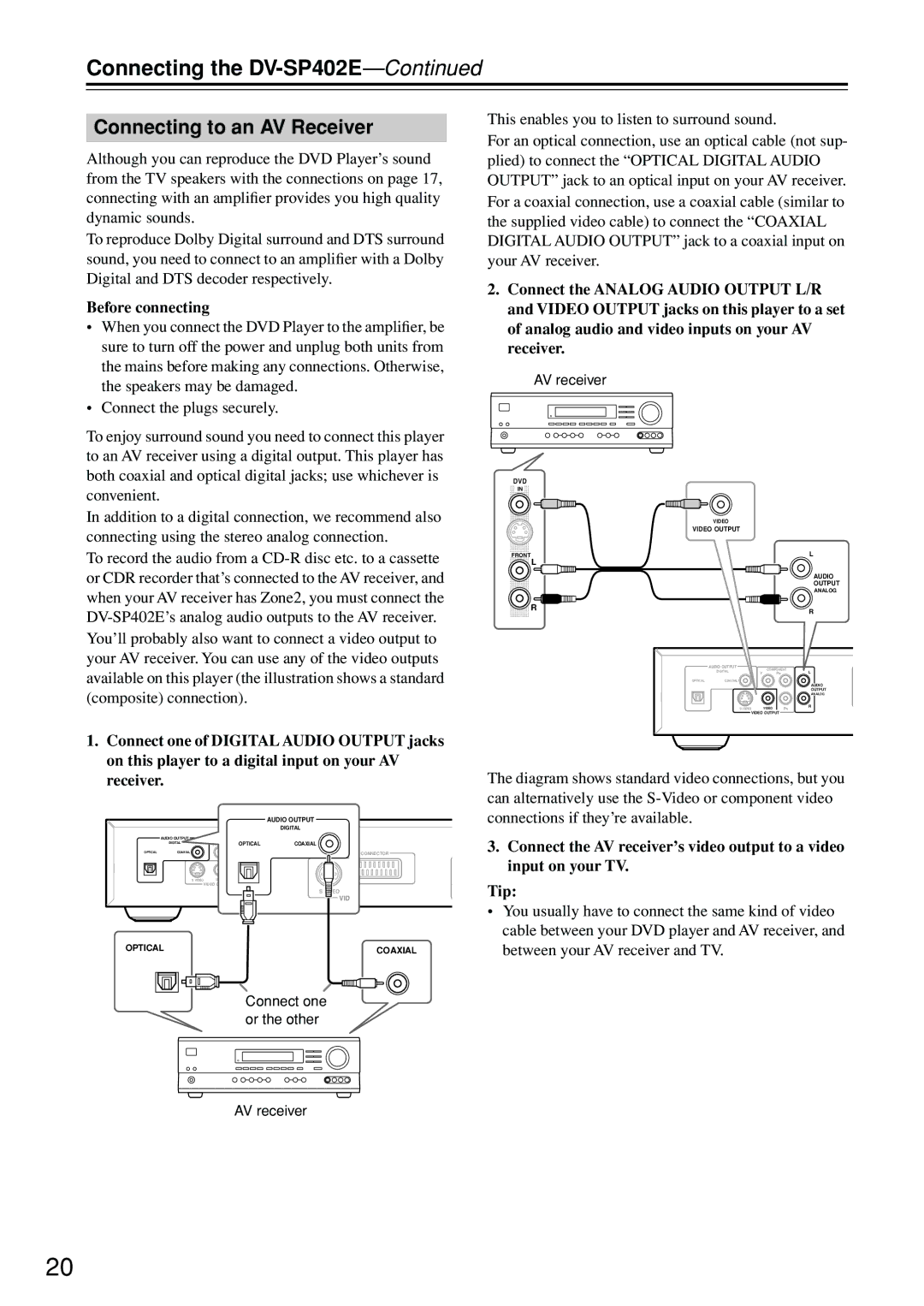
Connecting to an AV Receiver
Although you can reproduce the DVD Player’s sound from the TV speakers with the connections on page 17, connecting with an amplifier provides you high quality dynamic sounds.
To reproduce Dolby Digital surround and DTS surround sound, you need to connect to an amplifier with a Dolby Digital and DTS decoder respectively.
Before connecting
•When you connect the DVD Player to the amplifier, be sure to turn off the power and unplug both units from the mains before making any connections. Otherwise, the speakers may be damaged.
•Connect the plugs securely.
To enjoy surround sound you need to connect this player to an AV receiver using a digital output. This player has both coaxial and optical digital jacks; use whichever is convenient.
In addition to a digital connection, we recommend also connecting using the stereo analog connection.
To record the audio from a
You’ll probably also want to connect a video output to your AV receiver. You can use any of the video outputs available on this player (the illustration shows a standard (composite) connection).
1.Connect one of DIGITAL AUDIO OUTPUT jacks on this player to a digital input on your AV
This enables you to listen to surround sound.
For an optical connection, use an optical cable (not sup- plied) to connect the “OPTICAL DIGITAL AUDIO OUTPUT” jack to an optical input on your AV receiver. For a coaxial connection, use a coaxial cable (similar to the supplied video cable) to connect the “COAXIAL DIGITAL AUDIO OUTPUT” jack to a coaxial input on your AV receiver.
2.Connect the ANALOG AUDIO OUTPUT L/R and VIDEO OUTPUT jacks on this player to a set of analog audio and video inputs on your AV receiver.
AV receiver
DVD
![]() IN
IN![]()
| VIDEO |
|
|
|
VIDEO OUTPUT |
|
|
| |
FRONT |
|
|
| L |
L |
|
|
|
|
|
|
|
| AUDIO |
|
|
|
| OUTPUT |
|
|
|
| ANALOG |
R |
|
|
| R |
|
|
|
| |
| AUDIO OUTPUT |
| COMPONENT | |
| DIGITAL | Y | ||
|
| PB | L | |
OPTICAL | COAXIAL |
|
|
|
|
|
|
| AUDIO |
|
|
|
| OUTPUT |
|
|
|
| ANALOG |
| S VIDEO |
| VIDEO | R |
|
| PR | ||
VIDEO OUTPUT
receiver. |
|
|
|
|
|
| The diagram shows standard video connections, but you |
|
|
|
|
|
|
| can alternatively use the |
|
|
|
|
|
| AUDIO OUTPUT | connections if they’re available. |
|
|
|
|
|
| DIGITAL |
|
AUDIO OUTPUT |
|
| AUDIO |
|
| 3. Connect the AV receiver’s video output to a video | |
| COMPONENTOUTPUT |
| REMOTE | ||||
OPTICAL | DIGITAL |
|
| ||||
COAXIAL | Y |
| PB OPTICAL |
| AV CONNECTOR | ||
|
|
|
| ANALOG | L |
|
|
|
|
|
|
|
| AUDIO | input on your TV. |
|
|
|
|
|
| OUTPUT | |
|
|
|
|
|
| ANALOG | |
|
| S VIDEO | VIDEO | PR | R |
|
|
|
|
|
| Tip: | |||
|
| VIDEO OUTPUT |
|
| |||
|
|
|
|
|
| S VIDEO | |
|
|
|
|
|
|
| • You usually have to connect the same kind of video |
|
|
|
|
|
|
| cable between your DVD player and AV receiver, and |
OPTICAL |
|
|
|
|
| COAXIAL | between your AV receiver and TV. |
|
|
|
|
|
|
| |
|
|
|
| Connect one |
| ||
|
|
|
| or the other |
| ||
AV receiver
20
